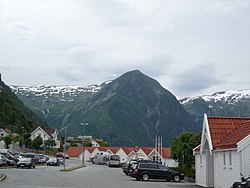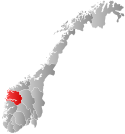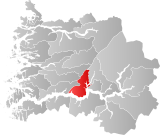Balestrand
Former municipality in Sogn og Fjordane, Norway From Wikipedia, the free encyclopedia
Former municipality in Sogn og Fjordane, Norway From Wikipedia, the free encyclopedia
Balestrand is a former municipality in Sogn og Fjordane county, Norway. It was located on the northern shore of the Sognefjorden in the traditional district of Sogn. The administrative center was the village of Balestrand. Other villages in the municipality included Ese, Kvamme, Låne, Sæle, Tjugum, and Vetlefjorden.
Balestrand Municipality
Balestrand kommune | |
|---|---|
 View of Balestrand | |
|
| |
 Sogn og Fjordane within Norway | |
 Balestrand within Sogn og Fjordane | |
| Coordinates: 61°10′39″N 06°24′14″E | |
| Country | Norway |
| County | Sogn og Fjordane |
| District | Sogn |
| Established | 1850 |
| • Preceded by | Leikanger Municipality |
| Disestablished | 1 Jan 2020 |
| • Succeeded by | Sogndal and Høyanger |
| Administrative centre | Balestrand |
| Government | |
| • Mayor (2011-2019) | Harald Offerdal (Ap) |
| Area (upon dissolution) | |
| • Total | 429.67 km2 (165.90 sq mi) |
| • Land | 411.04 km2 (158.70 sq mi) |
| • Water | 18.63 km2 (7.19 sq mi) 4.3% |
| • Rank | #231 in Norway |
| Population (2019) | |
| • Total | 1,279 |
| • Rank | #370 in Norway |
| • Density | 3.1/km2 (8/sq mi) |
| • Change (10 years) | |
| Demonym | Balestrending[1] |
| Official language | |
| • Norwegian form | Nynorsk |
| Time zone | UTC+01:00 (CET) |
| • Summer (DST) | UTC+02:00 (CEST) |
| ISO 3166 code | NO-1418[3] |
| Website | Official website |
The municipality was situated at the confluence of the Fjærlandsfjorden/Esefjorden and the main Sognefjorden. The major industries in the municipality were tourism and farming. Balestrand became popular early due to the interest of artists, such as Hans Gude, Kjartan Lauritzen, Alfred Heaton Cooper, Hans Dahl, and Johannes Flintoe. Their paintings of the scenery around Balestrand inspired visitors, and Balestrand maintains its connection with art. Other industries include made-to-order kitchen interiors, local apple juice, and Nesseplast which produces industrial plastic. The Norwegian National Road 13 runs through the municipality.
At the time of its dissolution in 2020, the 430-square-kilometre (170 sq mi) municipality was the 231st largest by area out of the 422 municipalities in Norway. Balestrand was the 370th most populous municipality in Norway with a population of 1,272. The municipality's population density was 3.1 inhabitants per square kilometre (8.0/sq mi) and its population had decreased by 5.1% over the previous decade.[4][5]
In 2016, the chief of police for Vestlandet formally suggested a reconfiguration of police districts and stations. He proposed that the police station in Balestrand be closed.[6]




Balestrand was established as a municipality in 1850 when the three sub-parishes (sokn) of Vangsnes, Tjugum, and Mundal in the northwestern part of the large Leikanger municipality were separated to form the new municipality of Balestrand. The initial population of the municipality was 2,122. In 1861, the Mundal sub-parish was renamed Fjærland.[7]
During the 1960s, there were many municipal mergers across Norway due to the work of the Schei Committee. On 1 January 1964 the municipalities of Vik, Leikanger, and Balestrand changed their boundaries in a land trade. The sub-parish of Vangsnes (population: 189) was transferred from Balestrand to Vik, Balestrand gained the sub-parish of Kvamsøy (population: 389) from Vik, and Leikanger gained the Hella-Eitorn area (population: 31) from Balestrand. Balestrand had a population of 1,606 after the changes were completed.[7]
The Fjærland area of Balestrand had always been isolated from the rest of the municipality, and only accessible by boat. In 1995, the Frudal Tunnel was completed connecting Fjærland to neighboring Sogndal municipality (not to the rest of Balestrand). This caused discussions about Fjærland's municipal future. On 1 January 2000, the entire sub-parish of Fjærland in northern Balestrand was transferred to Sogndal municipality.[7]
On 1 January 2020, Balestrand Municipality ceased to exist. The far western Nesse area of Balestrand was transferred to the neighboring Høyanger Municipality and the rest of Balestrand was merged with the neighboring municipalities of Leikanger and Sogndal to form a much larger municipality called Sogndal.[8][9]
The municipality is named Balestrand, a compound name for the area that was created in 1832 by the Norwegian writer Henrik Wergeland. The first element is the name of the old Bale farm (Old Norse: Bali). The farm name is identical to the word bali which means "grassy hillside". The last element is derived from the word strǫnd which means "beach" or "shore". Thus the "shore along the grassy hillside."[10][11]
The coat of arms was granted on 23 October 1989. The official blazon is "Azure, a down-pointing sword argent issuant from the base" (Norwegian: På blå grunn eit oppveksande nedvend sølv sverd). This means the arms have a blue field (background) and the charge is the hilt of a Viking sword. The charge has a tincture of argent which means it is commonly colored white, but if it is made out of metal, then silver is used. The design symbolizes an old Viking sword found in the burial mound in Balestrand. The sword is believed to belong to King Bele from Frithiof's Saga. The arms were designed by Inge Rotevatn. The municipal flag has the same design as the coat of arms.[12][13][14][15]
The Church of Norway had one parish (sokn) within the municipality of Balestrand. It was part of the Sogn prosti (deanery) in the Diocese of Bjørgvin.
| Parish (sokn) | Church name | Location of the church | Year built |
|---|---|---|---|
| Balestrand | Kvamsøy Church | Kvamsøy | 1290 |
| Sæle Church | Sæle | 1903 | |
| Tjugum Church | Tjugum | 1863 |
There is also one Anglican church in Balestrand:
While it existed, this municipality was responsible for primary education (through 10th grade), outpatient health services, senior citizen services, unemployment, social services, zoning, economic development, and municipal roads. During its existence, this municipality was governed by a municipal council of directly elected representatives. The mayor was indirectly elected by a vote of the municipal council.[16] The municipality was under the jurisdiction of the Sogn og Fjordane District Court and the Gulating Court of Appeal.
The municipal council (Kommunestyre) of Balestrand is made up of 17 representatives that are elected to four year terms. The party breakdown of the final municipal council was as follows:
| Party name (in Nynorsk) | Number of representatives | |
|---|---|---|
| Labour Party (Arbeidarpartiet) | 4 | |
| Conservative Party (Høgre) | 2 | |
| Christian Democratic Party (Kristeleg Folkeparti) | 3 | |
| Centre Party (Senterpartiet) | 5 | |
| Socialist Left Party (Sosialistisk Venstreparti) | 1 | |
| Liberal Party (Venstre) | 2 | |
| Total number of members: | 17 | |
| Party name (in Nynorsk) | Number of representatives | |
|---|---|---|
| Labour Party (Arbeidarpartiet) | 4 | |
| Conservative Party (Høgre) | 5 | |
| Christian Democratic Party (Kristeleg Folkeparti) | 2 | |
| Centre Party (Senterpartiet) | 3 | |
| Socialist Left Party (Sosialistisk Venstreparti) | 1 | |
| Liberal Party (Venstre) | 2 | |
| Total number of members: | 17 | |
| Party name (in Nynorsk) | Number of representatives | |
|---|---|---|
| Labour Party (Arbeidarpartiet) | 3 | |
| Conservative Party (Høgre) | 4 | |
| Christian Democratic Party (Kristeleg Folkeparti) | 3 | |
| Centre Party (Senterpartiet) | 4 | |
| Liberal Party (Venstre) | 3 | |
| Total number of members: | 17 | |
| Party name (in Nynorsk) | Number of representatives | |
|---|---|---|
| Labour Party (Arbeidarpartiet) | 4 | |
| Conservative Party (Høgre) | 2 | |
| Christian Democratic Party (Kristeleg Folkeparti) | 3 | |
| Centre Party (Senterpartiet) | 2 | |
| Socialist Left Party (Sosialistisk Venstreparti) | 2 | |
| Liberal Party (Venstre) | 4 | |
| Total number of members: | 17 | |
| Party name (in Nynorsk) | Number of representatives | |
|---|---|---|
| Labour Party (Arbeidarpartiet) | 4 | |
| Conservative Party (Høgre) | 2 | |
| Christian Democratic Party (Kristeleg Folkeparti) | 2 | |
| Centre Party (Senterpartiet) | 2 | |
| Liberal Party (Venstre) | 6 | |
| Joint list of the Red Electoral Alliance (Raud Valallianse) and the Socialist Left Party (Sosialistisk Venstreparti) | 1 | |
| Total number of members: | 17 | |
| Party name (in Nynorsk) | Number of representatives | |
|---|---|---|
| Labour Party (Arbeidarpartiet) | 4 | |
| Conservative Party (Høgre) | 2 | |
| Christian Democratic Party (Kristeleg Folkeparti) | 3 | |
| Centre Party (Senterpartiet) | 7 | |
| Liberal Party (Venstre) | 4 | |
| Joint list of the Red Electoral Alliance (Raud Valallianse) and the Socialist Left Party (Sosialistisk Venstreparti) | 1 | |
| Total number of members: | 21 | |
| Party name (in Nynorsk) | Number of representatives | |
|---|---|---|
| Labour Party (Arbeidarpartiet) | 4 | |
| Conservative Party (Høgre) | 3 | |
| Christian Democratic Party (Kristeleg Folkeparti) | 3 | |
| Red Electoral Alliance (Raud Valallianse) | 1 | |
| Centre Party (Senterpartiet) | 7 | |
| Liberal Party (Venstre) | 3 | |
| Total number of members: | 21 | |
| Party name (in Nynorsk) | Number of representatives | |
|---|---|---|
| Labour Party (Arbeidarpartiet) | 5 | |
| Conservative Party (Høgre) | 4 | |
| Christian Democratic Party (Kristeleg Folkeparti) | 4 | |
| Centre Party (Senterpartiet) | 6 | |
| Liberal Party (Venstre) | 2 | |
| Total number of members: | 21 | |
| Party name (in Nynorsk) | Number of representatives | |
|---|---|---|
| Labour Party (Arbeidarpartiet) | 5 | |
| Conservative Party (Høgre) | 4 | |
| Christian Democratic Party (Kristeleg Folkeparti) | 4 | |
| Centre Party (Senterpartiet) | 6 | |
| Liberal Party (Venstre) | 2 | |
| Total number of members: | 21 | |
| Party name (in Nynorsk) | Number of representatives | |
|---|---|---|
| Labour Party (Arbeidarpartiet) | 4 | |
| Conservative Party (Høgre) | 4 | |
| Christian Democratic Party (Kristeleg Folkeparti) | 3 | |
| Centre Party (Senterpartiet) | 6 | |
| Liberal Party (Venstre) | 3 | |
| Local list in Balestrand (Bygdalista i Balestrand) | 1 | |
| Total number of members: | 21 | |
| Party name (in Nynorsk) | Number of representatives | |
|---|---|---|
| Labour Party (Arbeidarpartiet) | 4 | |
| Conservative Party (Høgre) | 3 | |
| Christian Democratic Party (Kristeleg Folkeparti) | 4 | |
| Centre Party (Senterpartiet) | 8 | |
| Liberal Party (Venstre) | 2 | |
| Total number of members: | 21 | |
| Party name (in Nynorsk) | Number of representatives | |
|---|---|---|
| Labour Party (Arbeidarpartiet) | 4 | |
| Conservative Party (Høgre) | 3 | |
| Christian Democratic Party (Kristeleg Folkeparti) | 3 | |
| Centre Party (Senterpartiet) | 8 | |
| Liberal Party (Venstre) | 3 | |
| Total number of members: | 21 | |
| Party name (in Nynorsk) | Number of representatives | |
|---|---|---|
| Labour Party (Arbeidarpartiet) | 4 | |
| Conservative Party (Høgre) | 4 | |
| Centre Party (Senterpartiet) | 6 | |
| Liberal Party (Venstre) | 5 | |
| Local List(s) (Lokale lister) | 2 | |
| Total number of members: | 21 | |
| Party name (in Nynorsk) | Number of representatives | |
|---|---|---|
| Labour Party (Arbeidarpartiet) | 4 | |
| Conservative Party (Høgre) | 4 | |
| Centre Party (Senterpartiet) | 7 | |
| Liberal Party (Venstre) | 6 | |
| Total number of members: | 21 | |
| Party name (in Nynorsk) | Number of representatives | |
|---|---|---|
| Labour Party (Arbeidarpartiet) | 4 | |
| Conservative Party (Høgre) | 4 | |
| Centre Party (Senterpartiet) | 7 | |
| Liberal Party (Venstre) | 6 | |
| Total number of members: | 21 | |
| Party name (in Nynorsk) | Number of representatives | |
|---|---|---|
| Labour Party (Arbeidarpartiet) | 4 | |
| Conservative Party (Høgre) | 3 | |
| Farmers' Party (Bondepartiet) | 5 | |
| Liberal Party (Venstre) | 6 | |
| Local List(s) (Lokale lister) | 3 | |
| Total number of members: | 21 | |
| Party name (in Nynorsk) | Number of representatives | |
|---|---|---|
| Labour Party (Arbeidarpartiet) | 6 | |
| Conservative Party (Høgre) | 3 | |
| Farmers' Party (Bondepartiet) | 6 | |
| Liberal Party (Venstre) | 6 | |
| Local List(s) (Lokale lister) | 3 | |
| Total number of members: | 24 | |
| Party name (in Nynorsk) | Number of representatives | |
|---|---|---|
| Labour Party (Arbeidarpartiet) | 6 | |
| Conservative Party (Høgre) | 3 | |
| Farmers' Party (Bondepartiet) | 2 | |
| Liberal Party (Venstre) | 6 | |
| Joint List(s) of Non-Socialist Parties (Borgarlege Felleslister) | 3 | |
| Local List(s) (Lokale lister) | 4 | |
| Total number of members: | 24 | |
| Party name (in Nynorsk) | Number of representatives | |
|---|---|---|
| Labour Party (Arbeidarpartiet) | 3 | |
| Farmers' Party (Bondepartiet) | 2 | |
| Liberal Party (Venstre) | 3 | |
| List of workers, fishermen, and small farmholders (Arbeidarar, fiskarar, småbrukarar liste) | 3 | |
| Local List(s) (Lokale lister) | 13 | |
| Total number of members: | 24 | |
| Party name (in Nynorsk) | Number of representatives | |
|---|---|---|
| Labour Party (Arbeidarpartiet) | 5 | |
| Farmers' Party (Bondepartiet) | 5 | |
| Liberal Party (Venstre) | 3 | |
| Joint List(s) of Non-Socialist Parties (Borgarlege Felleslister) | 11 | |
| Total number of members: | 24 | |
| Note: Due to the German occupation of Norway during World War II, no elections were held for new municipal councils until after the war ended in 1945. | ||
Balestrand was located between the high snow-covered Gaularfjellet mountains in the center of the beautiful, lush Sognefjorden. Three fjord arms stretch inland, winding through the mountains and dotted with charming hamlets: Lånefjorden, Esefjorden, and Vetlefjorden. The Fjærlandsfjorden runs along the eastern border of the municipality. The Jostefonn glacier sits at the very northernmost part of the municipality.
Balestrand was bordered to the west by the municipalities of Høyanger and Gaular, to the north by Førde, and to the east by Sogndal and Leikanger. Across the Sognefjorden to the south is the municipality of Vik.


Built in the 19th century, the Kvikne's Hotel is one of the most famous buildings in Balestrand. The Kvikne family, who own the place, took it over in 1877. Since then the establishment has undergone constant development which continues to this day. There are many new buildings and remodeling and expansion projects have been carried out.
Today, the hotel is a highly modern facility resounding with tradition and culture. With 200 rooms, it is also one of Norway's largest fine hotels catering to tourists. An impressive collection of art and historical pieces is a central feature of the hotel's interior, and one of the elements of its distinct personality.
Kviknes Hotel was made popular for European visitors in the early part of the 20th century by Kaiser Wilhelm II, who often visited there during his summer vacations prior to World War I. The hotel still possesses the chair he used in their restaurant. The Kaiser is accompanied on the list by a number of emperors, kings, presidents, Prime ministers, film stars, and artists from many countries.[35]
St. Olaf's Church, also known as the English Church, is an Anglican church built in the style of a Stave church. The church was completed in 1897 as a memorial to Margaret Green. Margaret, an English lady, came to the fjords as a tourist to hike the mountains. She met, fell in love with and married Knut Kvikne who was an avid mountain man. Being a very pious woman, she wished for an Anglican church in Balestrand. She started the church with her husband, but died before its completion. Sunday services are held during the summer months, being conducted by rotating vicars from England.[35][36]
St. Olaf's Church is notable as the inspiration for the chapel in Elsa's coronation scene in the 2013 Disney film Frozen.[37]
Seamless Wikipedia browsing. On steroids.
Every time you click a link to Wikipedia, Wiktionary or Wikiquote in your browser's search results, it will show the modern Wikiwand interface.
Wikiwand extension is a five stars, simple, with minimum permission required to keep your browsing private, safe and transparent.